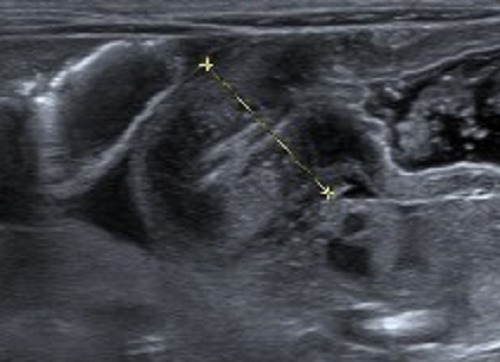Playlist
Show Playlist
Hide Playlist
Hypertrophic Pyloric Stenosis
-
Slides Hypertrophic pyloric stenosis Special Surgery.pdf
-
Download Lecture Overview
00:01 Welcome back. 00:02 Thanks for joining me on this discussion of hypertrophic pyloric stenosis in the section of pediatric surgery. 00:10 Hypertrophic pyloric stenosis was one of my favorite things to take care of when I was a resident because most babies do quite well and it’s extremely satisfying. 00:19 Let's take a look at the anatomy. 00:21 On the left side – left side of the screen is a normal anatomy. 00:25 You see the esophagus, the stomach tapering into the pyloric channel, and the first portion of the duodenum. 00:32 On the right side of the screen, you note that the channel – the pyloric channel, that is – is enlarged. 00:38 This is the area known as pyloric stenosis. 00:42 It is defined by the hypertrophy of the pylorus. 00:45 You can imagine then that with an obstruction there, babies may not do very well with feeds. 00:53 What's the common presentation for hypertrophic pyloric stenosis? It is more common in male babies and preterm infants and generally associated with the firstborn. 01:05 Of course, as you know, many patients don't present like textbooks. 01:08 Anything is possible. 01:12 What are some risk factors and etiology? Well, we don't really know. 01:16 It's unclear, the etiology, but it's important to recognize the associations. 01:21 Maternal smoking. 01:22 Remember, maternal smoking is associated with many, many problems in babies. 01:27 Hypertrophic pyloric stenosis is only one of them. 01:31 Once again, bottle-feeding. 01:33 Remember, our lecture on necrotizing enterocolitis and its association with bottle-fed babies? This is why many societies recommend breast-feeding. 01:44 There may be a genetic component, although we don't exactly know where the mutation lies. 01:49 There are some historical facts that some male babies also have fathers or cousins who have hypertrophic pyloric stenosis. 01:58 And there's also a loose association with the use of erythromycin. 02:03 The use of erythromycin has largely been abandoned in babies.
About the Lecture
The lecture Hypertrophic Pyloric Stenosis by Kevin Pei, MD is from the course Special Surgery.
Included Quiz Questions
Which of the following are NOT associated with hypertrophic pyloric stenosis?
- Breastfeeding
- Maternal smoking
- Family history of hypertrophic pyloric stenosis
- Male child
- Use of erythromycin
Which of the following individuals has the highest risk of hypertrophic pyloric stenosis?
- A firstborn child
- Asians
- Females
- African-Americans
- Breastfed child
Customer reviews
5,0 of 5 stars
| 5 Stars |
|
5 |
| 4 Stars |
|
0 |
| 3 Stars |
|
0 |
| 2 Stars |
|
0 |
| 1 Star |
|
0 |




